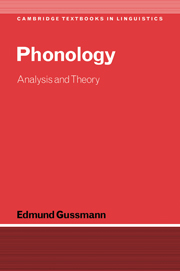Book contents
- Frontmatter
- Contents
- Preface
- List of abbreviations
- 1 Sounds and segments
- 2 The melody and the skeleton
- 3 Domains and phonological regularities
- 4 The syllable
- 5 More on codas
- 6 Some segmental regularities
- 7 Syllable structure and phonological effects: quantity in Icelandic
- 8 Segmental double agents
- 9 Words and feet: stress in Munster Irish
- Conclusion
- Appendix The phonetic alphabet of the International Phonetic Association
- References
- Index
4 - The syllable
Published online by Cambridge University Press: 05 June 2012
- Frontmatter
- Contents
- Preface
- List of abbreviations
- 1 Sounds and segments
- 2 The melody and the skeleton
- 3 Domains and phonological regularities
- 4 The syllable
- 5 More on codas
- 6 Some segmental regularities
- 7 Syllable structure and phonological effects: quantity in Icelandic
- 8 Segmental double agents
- 9 Words and feet: stress in Munster Irish
- Conclusion
- Appendix The phonetic alphabet of the International Phonetic Association
- References
- Index
Summary
Introduction
The syllable, just like the sound, seems to be intuitively familiar but on closer inspection turns out to be a very vague notion. The familiarity is largely due to the fact that the term is part of colloquial speech and is often used in discussions where language and language-related issues appear. A case in point are the conventions of breaking words at the end of a line; these are orthographic devices of different sorts and involve the ban, for example in English or German, of breaking certain letter combinations which denote a single sound: mother cannot be divided as *mot-her or German Bäche ‘stream, pl.’ as *Bäc-he. The requirement imposed by such conventions in a variety of languages is that the constituent parts of a broken word should form individual syllables, hence in English val-id is acceptable, while *vali-d is not; in Polish radość ‘joy’ may be split up as ra-dość but not as *rado-ść. Examples of this sort of convention can be found in all languages using alphabetical writing, which of course means that children learning to write are exposed to the term the syllable quite early in life. Needless to say, a linguist cannot unquestioningly accept a notion used to define a spelling practice and apply it to the functioning of the sound system. What is needed are phonological rather than orthographic arguments demonstrating the relevance of the syllable; in the following pages we will attempt to provide these and to examine the nature of syllabic organisation a little more closely.
- Type
- Chapter
- Information
- PhonologyAnalysis and Theory, pp. 66 - 90Publisher: Cambridge University PressPrint publication year: 2002



